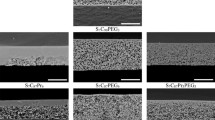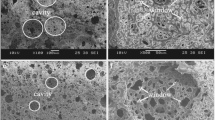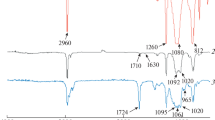Abstract
The morphological studies of poly(styrene)–poly(ethylene glycol)–chlorobenzene films have been performed using scanning electron microscopy. The average diameter of the holes present in the coatings decreased from 7.68 to 3.74 µm with the increase in the polymer content from 5 to 10%. The solvent played a major role in forming ordered porous polymer films. Asymmetric membrane formed at different concentrations of the ternary system. The effects of various parameters like polymer mass fraction, initial film thickness, and technique of application, on the pore size and uniformity have been studied. The membranes are formed at different concentrations of the ternary system.

















Similar content being viewed by others
References
A. Mirmohseni, A. Oladegaragoze, Construction of a sensor for determination of ammonia and aliphatic amines using polyvinylpyrrolidone coated quartz crystal microbalance. Sens. Actuators B 89, 164–172 (2003)
D. Wu, F. Xu, B. Sun, R. Fu, H. He, K. Matyjaszewski, Design and preparation of porous polymers. Chem. Rev. 112, 3959–4015 (2012)
O. Pitois, B. Francois, Formation of ordered micro-porous membranes. Eur. Phys. J. B 8, 225–231 (1999)
G. Widawski, M. Rawiso, B. François, Self-organized honeycomb morphology of star-polymer polystyrene films. Nature 369, 387 (1994)
B. Francois, Y. Ederle, C. Mathis, Honeycomb membranes made from C60 (PS) 6. Synth. Met. 103 (1999) 2362–2363
B. Ladewig, M.N.Z. Al-Shaeli, Fundamentals of membrane processes, in Fundamentals of Membrane Bioreactors (Springer, Singapore, 2017), pp. 13–37
D. Vaessen, A. McCormick, L. Francis, Effects of phase separation on stress development in polymeric coatings. Polymer 43, 2267–2277 (2002)
R.K. Arya, Phase separation in multicomponent polymer–solvent–nonsolvent coatings. S. Afr. J. Chem. Eng. 18, 30–40 (2013)
S.-T. Hsu, Y.L. Yao, Effect of film formation method and annealing on morphology and crystal structure of poly(l-lactic acid) films. J. Manuf. Sci. Eng. 136, 021006 (2014)
R.K. Arya, Calibration curves to measure concentrations in multicomponent polymeric coatings using confocal Raman spectroscopy. Int. J. Chem. Eng. Appl. 2, 421–424 (2011)
J. Sharma, R.K. Arya, S. Ahuja, C.K. Bhargava, Residual solvent study in polymer–polymer–solvent coatings: poly(styrene)–poly(methyl methacrylate)–tetrahydrofuran coatings. Prog. Org. Coat. 113, 200–206 (2017)
J. Sharma, K. Tewari, R.K. Arya, Diffusion in polymeric systems—a review on free volume theory. Prog. Org. Coat. 111, 83–92 (2017)
H. Yabu, M. Takebayashi, M. Tanaka, M. Shimomura, Superhydrophobic and lipophobic properties of self-organized honeycomb and pincushion structures. Langmuir 21, 3235–3237 (2005)
M. Srinivasarao, D. Collings, A. Philips, S. Patel, Three-dimensionally ordered array of air bubbles in a polymer film. Science 292, 79–83 (2001)
O. Karthaus, N. Maruyama, X. Cieren, M. Shimomura, H. Hasegawa, T. Hashimoto, Water-assisted formation of micrometer-size honeycomb patterns of polymers. Langmuir 16, 6071–6076 (2000)
B. de Boer, U. Stalmach, H. Nijland, G. Hadziioannou, Microporous honeycomb-structured films of semiconducting block copolymers and their use as patterned templates. Adv. Mater. 12, 1581–1583 (2000)
H. Yabu, M. Tanaka, K. Ijiro, M. Shimomura, Preparation of honeycomb-patterned polyimide films by self-organization. Langmuir 19, 6297–6300 (2003)
H. Matsuyama, M. Nishiguchi, Y. Kitamura, Phase separation mechanism during membrane formation by dry-cast process. J. Appl. Polym. Sci. 77, 776–783 (2000)
B. François, O. Pitois, J. François, Polymer films with a self-organized honeycomb morphology. Adv. Mater. 7, 1041–1044 (1995)
L. Ghannam, M. Manguian, J. François, L. Billon, A versatile route to functional biomimetic coatings: ionomers for honeycomb-like structures. Soft Matter 3, 1492–1499 (2007)
M. Nicho, D. Peña-Salgado, P. Altuzar-Coello, Morphological and physicochemical properties of spin-coated poly(3-octylthiophene)/polystyrene composite thin films. Thin Solid Films 518, 1799–1803 (2010)
I. Sharifian, Conductive and biodegradable polyaniline/starch blends and their composites with polystyrene. Iran. Polym. J. 20, 319–328 (2011)
E. Ferrari, P. Fabbri, F. Pilati, Solvent and substrate contributions to the formation of breath figure patterns in polystyrene films. Langmuir 27, 1874–1881 (2011)
C. Panayiotou, J. Vera, Thermodynamics of polymer–polymer–solvent and block copolymer–solvent systems. I. Experimental measurements. Polym. J. 16, 89–102 (1984)
C. Panayiotou, J. Vera, Thermodynamics of polymer–polymer–solvent and block copolymer–solvent systems. II. Theoretical treatment of data with the nonrandom new Flory theory. Polym. J. 16, 103–112 (1984)
A. Clark, Direct analysis of experimental tie line data (two polymer–one solvent systems) using Flory–Huggins theory. Carbohydr. Polym. 42, 337–351 (2000)
P.E. Price, I.H. Romdhane, Multicomponent diffusion theory and its applications to polymer–solvent systems. AIChE J. 49, 309–322 (2003)
Acknowledgements
The authors are grateful to the Science and Engineering Research Board-Department of Science and Technology, New Delhi, India (Project File No. EEQ/2016/000015) for the research funding, and the Thapar Institute of Engineering and Technology, Patiala, for the Seed Grant and other necessary facilities to conduct this research. Authors also like to thank to Mr. Aadil Batla, Ph.D Scholar, School of Chemistry and Biochemistry, TIET Patiala for helping in image analysis.
Author information
Authors and Affiliations
Corresponding author
Rights and permissions
About this article
Cite this article
Sharma, J., Arya, R.K. & Ahuja, S. Drying induced phase separation in poly(styrene)–poly(ethylene glycol)–chlorobenzene system. J Porous Mater 26, 1043–1057 (2019). https://doi.org/10.1007/s10934-018-0704-2
Published:
Issue Date:
DOI: https://doi.org/10.1007/s10934-018-0704-2




